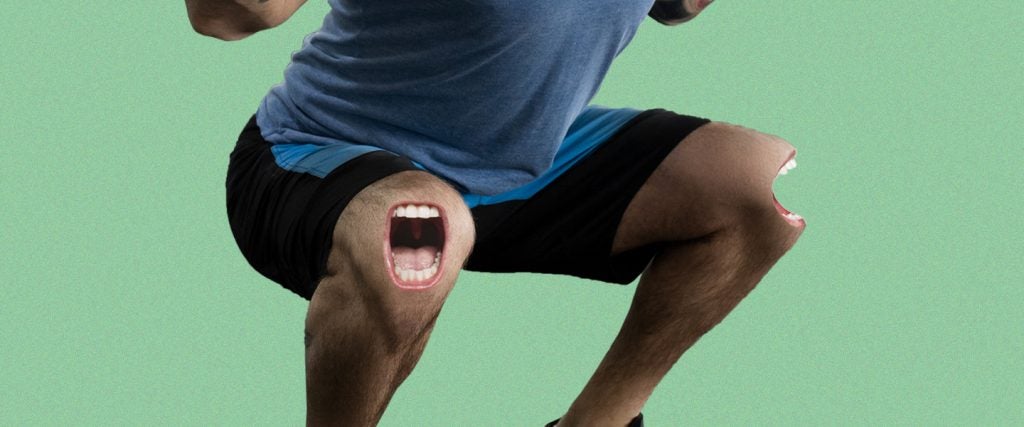Leg day at the Bally Total Fitness Executive Club was always daunting. I arrived at 7 a.m., and I knew that when I left, I’d spend the next three days looking like I’d forgotten how to walk. Not to mention, at some invariable point between squats, leg presses, lunges and leg extensions, I’d experience some form of discomfort in my knees, which I’d mention to the other trainers in the group. Things like, “My torn knee is acting up again. I don’t think I can go that heavy on the leg extension.”
These complaints never evoked the sympathy I expected. “I had a full knee replacement — building up your legs is the only way to make that pain disappear,” Chris, a fellow trainer, would chide in response.
Whether or not Chris was correct is neither here nor there. The point is, knee pain is common during leg workouts, and it’s a good idea to identify its root cause before you pack hundreds of pounds onto a weight bar thinking you’re going to alleviate the symptoms, only to ultimately cause your knee to deteriorate even further.
Exactly why is it that my knee hurts during squats?
To start, there’s a difference between your knees making sounds — crackling and popping is typically harmless — and actual pain. Because once you’re experiencing pain, harm is already in your midst. So let’s diagnose that pain and determine exactly what it is about your squats that are causing problems.
We’ll begin from the presumption that your knees are in perfect working order during the 23 hours and 52 minutes a day you’re not squatting, and that the pain only reveals itself during your exertions at the squat rack. If that’s the case, it’s best to take a good, hard look at your squatting form.
You never want your knees to pass in front of your toes during a squat. If they do, you’re likely to experience the very sort of pain you’re complaining about, and an injury will be all but imminent. To remedy this, your initial squatting instinct shouldn’t be to dip forward at your knees; it should be to move your butt backwards and down, clearing a pathway for your body to travel that won’t require it to pass directly over your toes.
Also, in order to maximize the position that you’re able to draw power from, you’ll want to widen your feet to at least shoulder width apart. There are some purists out there who would say that you never want your feet to be wider than your shoulders, but optimal placement varies a bit based on individual leg length and other factors. Besides, it’s far better to have a squat that’s slightly inefficient because your feet are a hair too far apart than to spend several months nursing a knee injury.
Trust me — my squat form is perfect. What else could it be?
If you’ve been working out for a while, tendonitis is going to be your most likely culprit. Tendonitis is an overuse injury that occurs after a lot of repetitive movements have been performed by a joint. The likelihood that you’ll experience tendonitis increases with the amount of force at play in the movement, which is exactly the sort of formula that a squatting arrangement is tailor-made for.
Something else to keep in mind is that one in four American adults suffers from arthritis, one in four arthritis sufferers has to deal with severe joint pain and one in 10 adults has to limit their activity level because of arthritis. Granted, arthritis is more likely to be the cause of your problems if you’re older, but that doesn’t mean an early onset of arthritis won’t compromise your squatting capabilities.
Then, of course, there are injuries. Any sort of tear to the tendons or cartilage is certainly going to cause pain while you squat — and obviously during other activities, too — and will probably be an obvious source of tremendous discomfort. If this is the case, you have no business spending any time at a squatting station unless you’re only there to count reps for your gym buddy. Instead, seek a doctor’s assistance if you suspect that the problem you’re dealing with is more severe than tendonitis or arthritis.
What if it is just tendonitis? Do I stop squatting until it goes away?
Take at least a few days off of leg training, ice the joint down and keep it elevated if you can. Because no matter what guys like Chris say, squats are the last place you want to abide by the meathead mantra, “No pain, no gain.” Your (fully functioning) knees will thank you later.

